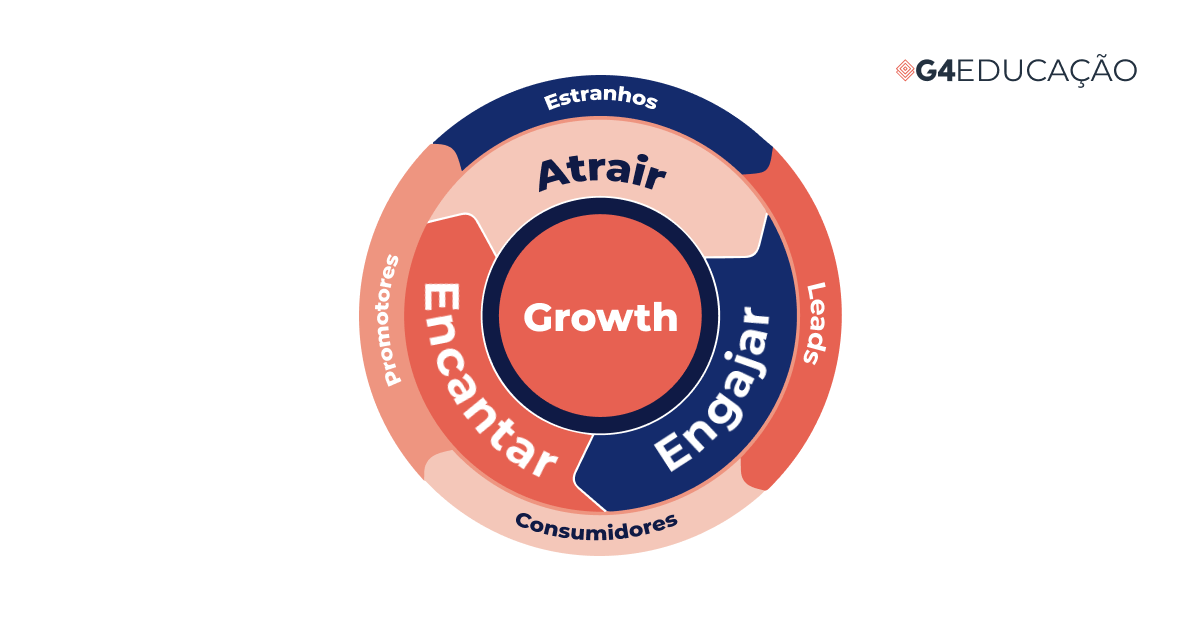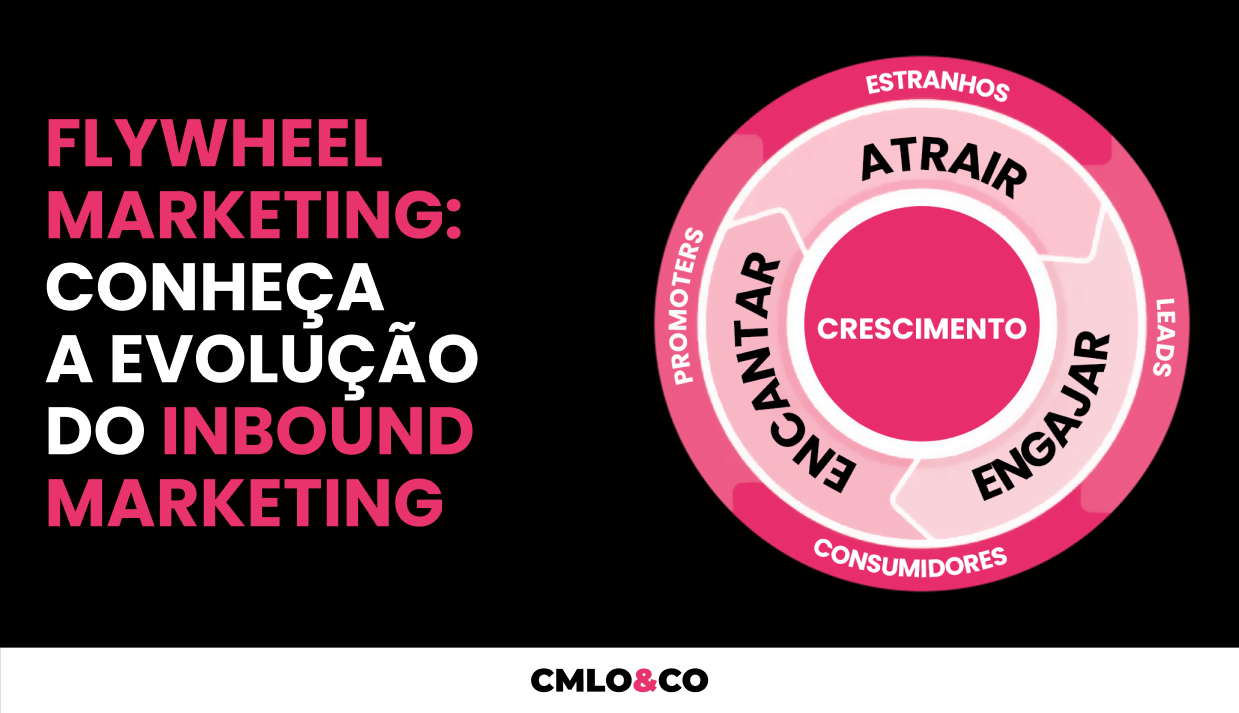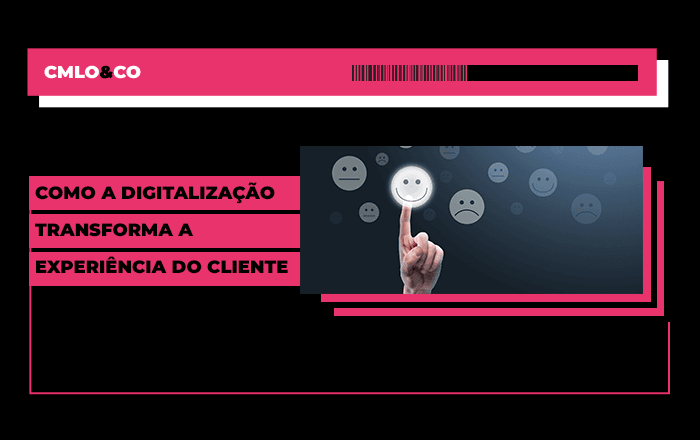In the constantly evolving digital marketing landscape, new approaches and concepts are emerging to meet the demands and challenges of the market.

One of these notable developments is the concept of Flywheel Marketing, which represents a significant change in the way companies approach the process of attracting, converting and retaining customers.
In this article, you'll learn all about it. Follow along!
What is Flywheel Marketing?
In principle, it is a customer-centered approach that aims to create a continuous cycle of sustainable growth for companies. Inspired by the physical concept of the flywheel, Flywheel Marketing was created by James Watt and popularized by HubSpot as an evolution of traditional Inbound Marketing.
While Inbound Marketing focuses on attracting, converting and delighting customers, Flywheel Marketing goes further, also integrating the stages of engaging and delighting existing customers to drive exponential business growth.
The idea behind the strategy is to create a fluid and continuous experience for the customer, where every positive interaction drives them further along the buying cycle and beyond. This is achieved by providing relevant and personalized content, exceptional shopping experiences and a continuous focus on customer success.
How do the stages of Flywheel Marketing work?
The new inbound marketing operates in three main stages, which feed and drive each other to create a cycle of continuous growth:
Attraction
In the first stage, the focus is on attracting potential customers through valuable content and SEO strategies, social media and other inbound marketing tactics. The aim is to generate interest in and awareness of the brand and its products or services.
Engagement and conversion
Once attracted, potential customers are engaged through meaningful and personalized interactions.
This can include providing educational content, offering useful resources and targeted communication based on the customer's needs and interests. The aim is to convert these leads into satisfied and engaged customers.
Enchantment and retention
After conversion, the focus shifts to delighting and retaining existing customers, offering exceptional support, memorable shopping experiences and ongoing engagement opportunities.
The aim is to turn customers into enthusiastic brand promoters who are willing to share their positive experience with others.

Source: G4 Education
Differences between Flywheel Marketing and Inbound Marketing
Although Flywheel Marketing is considered an evolution of Inbound Marketing, there are some key differences between these approaches:
Customer focus
While Inbound Marketing has a primary focus on lead generation and conversions, Flywheel goes further, putting the customer at the center of all marketing and sales activities. This is reflected in a greater emphasis on customer retention and success.
After-sales integration
Flywheel Marketing explicitly includes the customer delight and retention stage as an integral part of the growth cycle. This recognizes the importance of after-sales in building lasting relationships and maximizing customer value over time.
Holistic approach to the customer lifecycle
While Inbound Marketing tends to focus more on the initial stages of the customer lifecycle, such as attraction and conversion, Flywheel Marketing takes a more holistic approach, covering the entire customer lifecycle, from initial attraction to retention and advocacy.
Why invest in the new Inbound Marketing?
Flywheel Marketing offers a number of distinct advantages for companies looking to boost their growth and build lasting relationships with customers. Here are 7 of its many advantages:
- Continuous growth cycle: by integrating customer delight and retention into the growth cycle, Flywheel Marketing creates a constant flow of new business opportunities and revenue.
- Customer focus: by prioritizing customer success, the strategy helps companies build stronger, longer-lasting relationships with their customers, resulting in greater brand loyalty.
- Operational efficiency: by optimizing and automating marketing and sales processes, the new Inbound Marketing allows companies to operate in a more efficient and scalable way, reducing costs and increasing productivity.
- Increased customer value: by focusing on customer delight and retention, Flywheel Marketing helps companies maximize customer value over time, increasing lifetime value (LTV) and return on investment (ROI).
- Resistance to change: by creating a sustainable, customer-centered growth cycle, the marketing strategy makes companies more resilient to changes in the market and competition.
- Increased brand advocacy: satisfied and engaged customers are more likely to become enthusiastic brand advocates, sharing their positive experience with others and extending the company's reach.
- Continuous innovation: Flywheel Marketing encourages experimentation and continuous innovation, allowing companies to adapt quickly to changes in the market and customer needs.
7 tips for effective Flywheel Marketing
Do you want to apply the new Inbound Marketing to your company's communication and sales strategies? Then check out 7 essential tips for success with this approach!
1. map the customer life cycle comprehensively
Before starting your Flywheel Marketing strategies, it is essential to have a thorough understanding of the customer lifecycle.
This includes everything from the moment they become aware of your brand to the post-purchase phase, including support interactions and possible repurchases.
By mapping each stage of the customer lifecycle, you will be able to identify key opportunities for engagement and delight, feeding your Flywheel efficiently.
2. Personalize customer experiences
To apply the strategy efficiently in your company, it's also worth using data and insights about your customers to personalize your interactions at all points of contact.
This includes everything from segmenting marketing campaigns to customizing support communications. The more personalized the customer experience, the more likely it is to generate engagement and create brand advocates.
3. Automate repetitive processes
In addition, automate repetitive and routine tasks, such as sending post-sales follow-up emails, product updates and renewal reminders.
By doing so, you will save time and resources, and ensure a consistent and scalable approach throughout the customer lifecycle.
4. Offer quality customer support
Remember: customer support is an essential part of Flywheel Marketing, as satisfied customers tend to become enthusiastic brand advocates.
Make sure, therefore, that you offer quality support on all available channels, responding promptly to queries and resolving customer problems quickly and efficiently.
5. Encourage customer advocacy
Create incentive and reward programs to encourage customers to become active advocates of your brand.
It's worth offering everything from discounts in exchange for positive reviews to referral programs that reward customers for bringing new business to your company.
Customer advocacy is a powerful word-of-mouth marketing tool that can significantly boost the growth of your business.
6. Continuously analyze and optimize your strategies
Also remember to analyze the impact of your Flywheel Marketing strategies and identify areas of opportunity for optimization.
Use data and performance metrics and always keep an eye on customer feedback and market trends. And, where necessary, adjust your approaches as needed to ensure that they remain effective and relevant over time.
7. Promote a customer-centric culture throughout the company
Cultivate an organizational culture that values and prioritizes customer success at all levels of the company, from leadership to frontline teams.
For your Flywheel Marketing strategy to be successful, everyone must be aligned around the common goal of providing an exceptional customer experience at every touchpoint.
A customer-centric culture is essential for the success and long-term sustainable growth of the business.
Conclusion
Flywheel Marketing represents a significant evolution in digital marketing, offering a customer-centered approach geared towards the sustainable growth of companies.
By integrating customer delight and retention into the growth cycle, the strategy creates a continuous flow of business opportunities and revenue, driving long-term success.
At CMLO&CO, we offer holistic digital marketing solutionsincluding Flywheel Marketing strategies customized to meet the specific needs of your business.
Contact us today to find out how we can help you achieve your growth and success goals.







